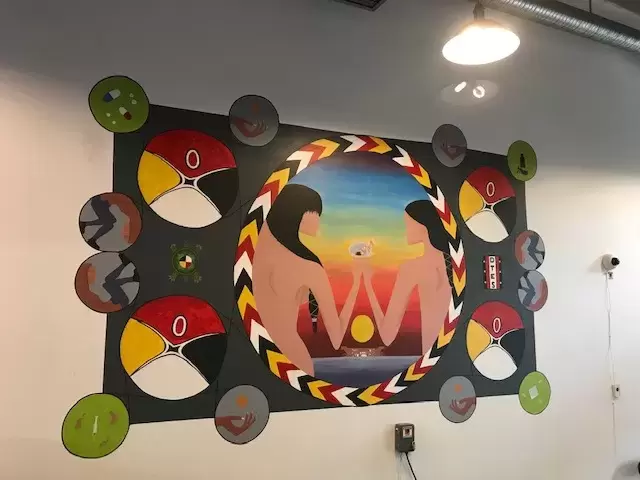A young Ditidaht member is quickly gaining ground in her career as an artist. On June 19, at the downtown location of the Aboriginal Front Door Society, a beautiful wall mural was unveiled, by 20-year-old artist Martina Giesbrecht.
A ceremony was held around the unveiling Friday, and a few notable chiefs and politicians attended the event.
“It was really emotional,” said Geisbrecht’s grandmother, Mary Durocher, who was present for the unveiling.
Durocher is a peer worker at the Aboriginal Front Door Society (AFDS), though normally works as a cultural advisor and elder. Due to COVID-19 restrictions and cutbacks, her duties and hours have shifted temporarily.
“She just graduated a few years ago, and art is what she loves doing. I’m really proud of her, and what she can do, and how she goes about it. She listens to what people ask for,” said Durocher of her granddaughter’s talent.
The unveiling event was hosted at the AFDS main office in Vancouver’s Downtown Eastside.
There was drumming, singing and opening prayers, along with Geisbrecht’s father singing a few songs, too. Then Ditidaht Hereditary Chief Arnold Shaw spoke, followed by a moving speech by Melanie Mark, B.C.’s minister of Advanced Education, Skills and Training and MLA for Vancouver-Mount Pleasant.
Geisbrecht then unveiled her mural—which was actually covered by a real veil to add to the excitement, said Dionne.
“It was covered with a black veil first, but that was inserted with subtext, so one of our elders replaced it with a see-through table cloth and some tape,” said Dionne, of the scene right before the unveiling. “It looked really vibrant afterwards. Really colorful. You could see it through the table cloth, but when it was unveiled it was way brighter.”
According to Geisbrecht, her piece signifies the struggle for a lot of people in the Downtown Eastside. She’s seen it herself, and heard what it’s like from her grandmother. The addictions, homelessness, and poverty, as well as the loss of cultural and family connections, are something she has a lot of compassion for, and wanted to illustrate as best she could in her painting. Of course, staff at the AFDS gave her tips along the way, about what they’d like to see, too, she said.
The key piece of her mural is that there is hope for healing drawn into it—because that’s what the staff at the AFDS aim to do, Geisbrecht added.
Through culture as well as other kinds of support, including offering snacks and water to people on the street, staff at AFDS work every day to try to bring people closer to recovery from the struggles they’re involved in. The mural is called “A Journey to a Better Life” in honour of the work being carried out at AFDS.
It’s a rectangle image, covering one wall of the inside of AFDS. There are many circles inside the image, each of which contains something inside of it that represents either the struggle or the healing from it.
Around the outside of the mural, four circles contain images of addiction—pills, cocaine, a needle, and an alcohol bottle. Four circles near to those have pictures of a person inside of them, representing the entrapment that is homelessness. Very often it’s hard to get out of once a person is stuck inside of that, Geisbrecht said, and she knows there is also a lot of judgement from people not stuck in that situation, which doesn’t help, she added.
There are also four circles closer to the center, with a hand and single coin in each one, representing poverty; the logo for the AFDS; the logo for the Downtown Eastside; and a Turtle Island symbol, to represent all Indigenous people across Turtle Island.
Finally, there is a very large circle in the centre of the image with two people in it, surrounded by a weaved circle with the colors of the medicine wheel. They’re holding a Smudge bowl, which represents the healing they’ve found through culture and ceremony.
There is a sunrise, and a canoe with an otter as well—a detail she added to pay respect to all the Coast Salish people whose territory AFDS is on.
“A couple of Chiefs spoke and congratulated me, and actually told me my mural was going to be part of history now… which totally made me feel happy inside,” said Geisbrecht.







